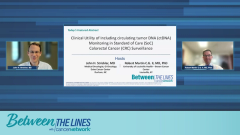
Future Directions: ctDNA Testing and Management of the CRC Patient
Experts discuss how the evolving landscape of patient access to medical information challenges clinicians to stay current and communicate effectively, while emphasizing the expanding role of circulating tumor DNA testing across multiple cancers—offering more precise, personalized treatment guidance and paving the way for earlier, targeted interventions that improve patient outcomes and quality of life.
Episodes in this series

The way patients access medical information has changed dramatically in recent years with the rise of the internet, artificial intelligence, and online patient communities. This transformation means healthcareealth care providers now face the dual challenge of staying current with rapidly evolving research while addressing misinformation that patients might encounter. Patients are increasingly informed and expect transparent, up-to-date discussions about their care, which demands a high level of engagement and communication from clinicians.
Looking ahead, the use of circulating tumor DNA testing is expected to expand quickly across many solid tumors, including some of the most challenging cancers like hepatopancreatobiliary malignancies. This technology is already providing significant clinical guidance and reassurance to patients, helping confirm that treatment decisions are appropriate. Moreover, emerging data on the quantitative levels of minimal residual disease (MRD) detected by these tests may soon guide treatment changes, such as switching chemotherapy regimens even when traditional imaging and tumor markers suggest stable disease. This shift would mark a major advance in personalized cancer care, allowing more timely and precise interventions.
Ultimately, the future of cancer care lies in integrating advanced biomarker data with cutting-edge therapies to improve patient outcomes. Early application of these treatments, particularly in low-volume disease states, offers the best chance for long-term success with fewer side adverse effects. As the information gap between doctors and patients narrows, more sophisticated conversations will become the norm, empowering patients and providers alike. This evolution holds great promise for improving quality of life and survival, underscoring the importance of continued innovation and education in this rapidly advancing field.
Newsletter
Stay up to date on recent advances in the multidisciplinary approach to cancer.














































































